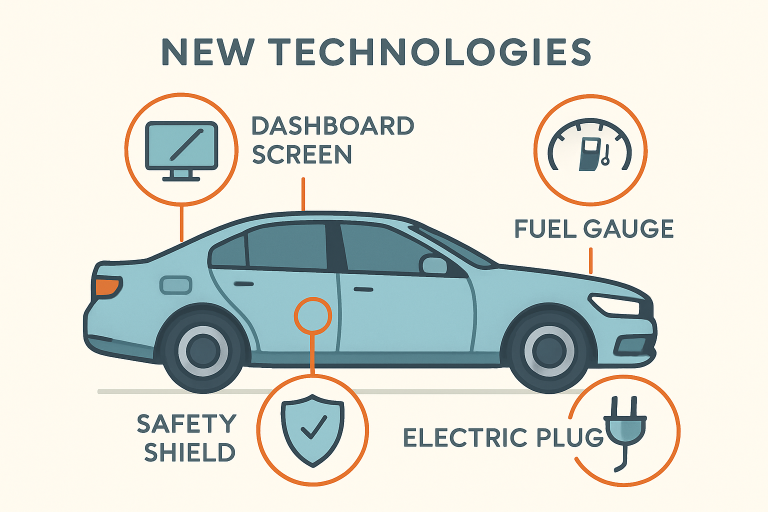Recent automotive advancements have made vehicles safer, more comfortable, and eco-friendly, with features like advanced safety systems, improved fuel efficiency, and seamless connectivity now common in many models. For those considering an upgrade or a new purchase, understanding the diverse benefits of these ever-evolving technologies is essential for making the most informed and future-ready decision. Learn more about the latest vehicles and how modern technology can enhance your driving experience by exploring current inventory options available from reputable dealerships and manufacturers. Keeping up with new vehicle technology enhances comfort, boosts safety and performance, promotes sustainability, and can lead to long-term savings, empowering consumers to make smarter purchasing decisions.
Enhanced Safety Features
Modern vehicles have set new benchmarks for on-road safety, thanks to innovative features such as automatic emergency braking (AEB), adaptive headlights, lane-keeping assistance, and electronic stability control. These technologies act as a co-driver, constantly monitoring surroundings and responding faster than human reflexes. The rapid development of high-resolution cameras, radar sensors, and machine learning algorithms enables the reliable performance of these systems across a wide range of driving conditions, from inclement weather to heavy traffic. The integration of these features has driven a measurable decline in accident rates, making our roads safer one innovation at a time.
Improved Fuel Efficiency
As fuel prices fluctuate and climate concerns intensify, automakers are pushing the envelope with engines and lightweight materials that offer improved fuel efficiency, resulting in more miles per gallon. Advancements like direct fuel injection, turbocharging, variable valve timing, and start-stop technology work in harmony to maximize combustion efficiency, resulting in lower fuel consumption. The use of high-strength yet lightweight metals such as aluminum and magnesium also reduces vehicle weight, further improving energy efficiency. For drivers, this translates to fewer stops at the gas station, a reduction in overall fuel expenses, and a significant decrease in harmful emissions. In the long run, improved fuel efficiency benefits not only individuals but society as a whole by helping decrease national dependency on fossil fuels and supporting efforts to address global warming.
Advanced Driver Assistance Systems
Adaptive Cruise Control and Blind-Spot Monitoring
Advanced Driver Assistance Systems (ADAS) represent a transformative leap forward in automotive safety and driver convenience. ADAS features, such as adaptive cruise control, automatically adjust the vehicle’s speed to maintain a safe distance from other cars, making long highway drives much more relaxing. Blind-spot monitoring further increases driver situational awareness by alerting occupants to hazards lurking just outside their field of vision. Other critical ADAS technologies include lane departure warning, rear cross-traffic alerts, and traffic sign recognition—each designed to address common causes of accidents, such as distracted driving or misreading road signs. By reducing the potential for human error behind the wheel, ADAS contributes to a significant reduction in roadway injuries and fatalities, while also making the driving experience less stressful and more enjoyable overall.
Connectivity and Infotainment
Today’s drivers expect seamless integration between their cars and digital lives. Modern infotainment systems provide real-time navigation, music streaming, smartphone syncing, and hands-free calling, all through intuitive and user-friendly interfaces. As highlighted by Consumer Reports, these technologies are evolving rapidly, offering more responsive touchscreens, better voice control, and greater customization options. These features go beyond simple convenience; platforms like Apple CarPlay, Android Auto, and advanced in-dash Wi-Fi connectivity enable drivers to stay connected without compromising their attention to the road. Over-the-air software updates mean infotainment systems can continuously improve with added features or security patches.

Predictive Maintenance
Gone are the days of unexpected breakdowns and guesswork maintenance routines. Predictive maintenance technology leverages sensors, telematics, and advanced diagnostic software to provide real-time status reports on every critical system within the vehicle. Owners receive alerts directly through their vehicle’s dashboards or mobile apps whenever an issue is detected, empowering them to take preventive action before minor problems escalate into major repairs. This proactive approach to vehicle health management results in higher reliability, fewer roadside breakdowns, and lower repair costs. For commercial vehicle fleets, predictive maintenance dramatically reduces downtime, while everyday drivers enjoy peace of mind and extended vehicle longevity, ultimately enhancing resale value.
Environmental Impact
The automotive industry’s pivot toward sustainability is more evident today than ever, with a pronounced surge in electric vehicles (EVs), plug-in hybrids, and other eco-friendly options. EVs, which release zero tailpipe emissions, have become a crucial component in global efforts to address urban air pollution and fight against the pressing threat of climate change. Hybrid vehicles combine fuel-efficient gasoline engines with electric power, resulting in dramatically lower emissions compared to traditional combustion engines. Meanwhile, manufacturers are also making strides in sustainable manufacturing practices and recycled materials.
Economic Benefits
Although the initial purchase price of new vehicles equipped with high-end technology may be higher, the long-term savings associated with these innovations are significant. Improved fuel economy results in fewer trips to the pump, while predictive maintenance and longer-lasting components reduce the frequency and severity of repairs. Additionally, government incentives, tax rebates, and lower registration fees are often available for electric and hybrid vehicle buyers. Lower overall maintenance costs combined with increased reliability also contribute to greater long-term savings throughout ownership. Furthermore, vehicles equipped with advanced safety and technology features tend to retain their value better, providing drivers with higher resale prices when it’s time to trade in for something new.
Future Trends
The automotive industry is on the brink of transformative advancements, with rapid progress in autonomous driving, vehicle-to-everything communication, and eco-friendly energy solutions. These innovations aim to enhance safety, reduce congestion, and minimize environmental impact, shaping smarter cities and improving quality of life. As technology continues to evolve, drivers can look forward to safer, more efficient, and more sustainable transportation experiences.
Driving Toward a Smarter and Safer Future
The pace of innovation in the automotive industry shows no signs of slowing, with each advancement delivering tangible benefits for drivers, passengers, and the planet. From cutting-edge safety features and improved fuel efficiency to connected infotainment systems and predictive maintenance, these technologies work together to create a more seamless, sustainable, and enjoyable driving experience.
For consumers, understanding these developments means more than simply keeping up with the latest trends—it’s about making informed decisions that can improve safety, reduce costs, and support a greener future. As manufacturers continue to push boundaries and integrate groundbreaking solutions, today’s drivers are not just purchasing a vehicle; they’re investing in a smarter, safer, and more responsible way to move through the world.








